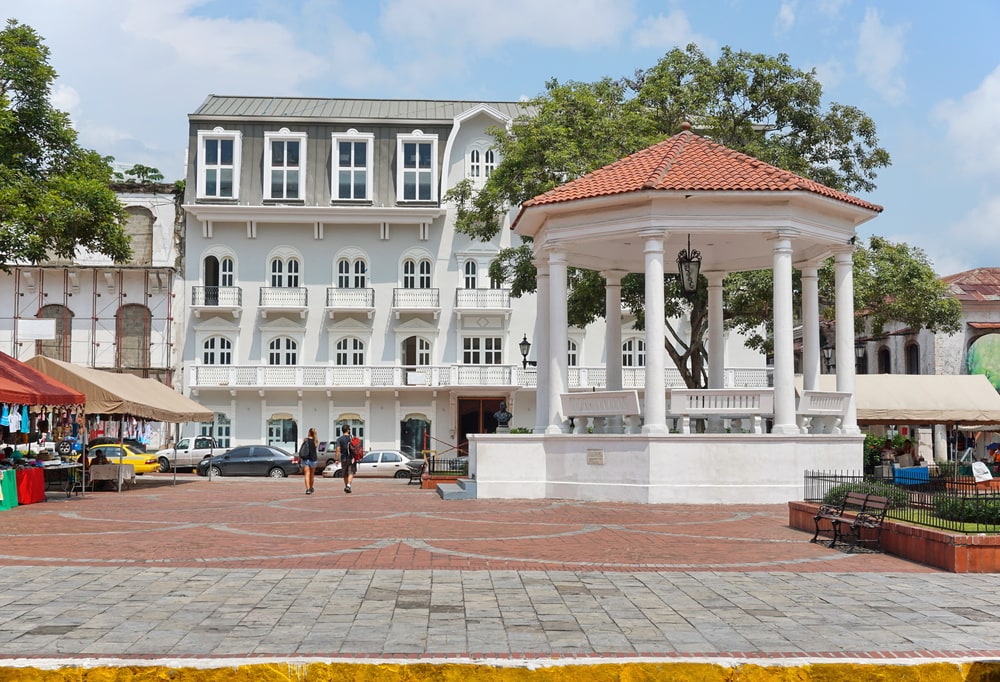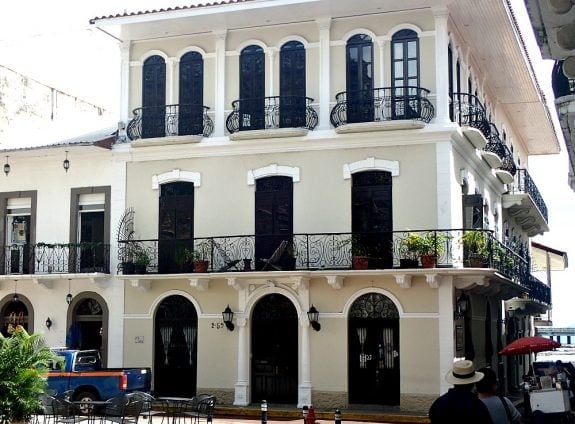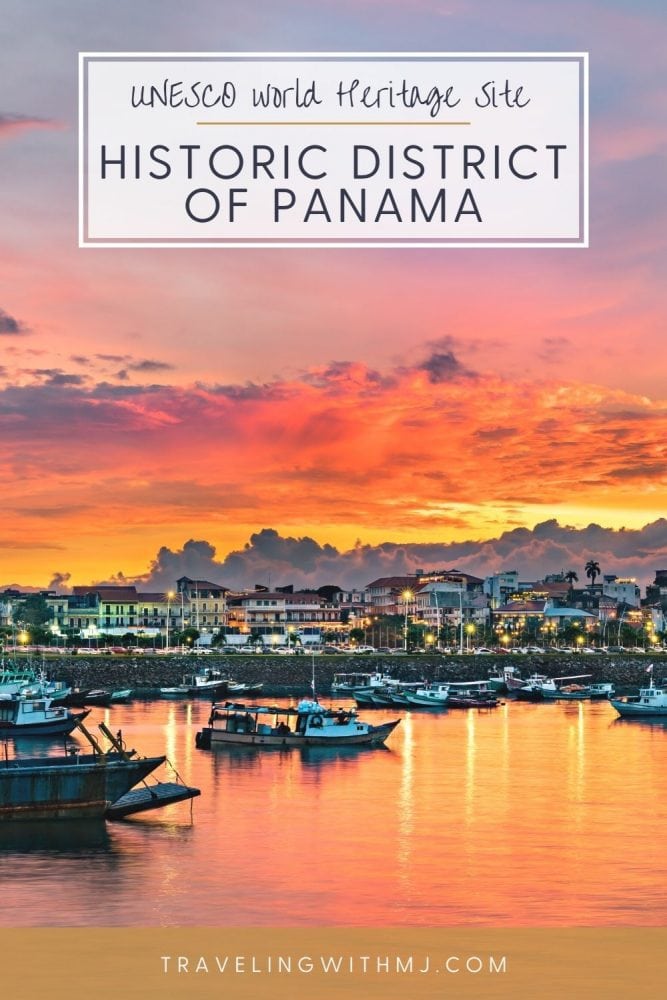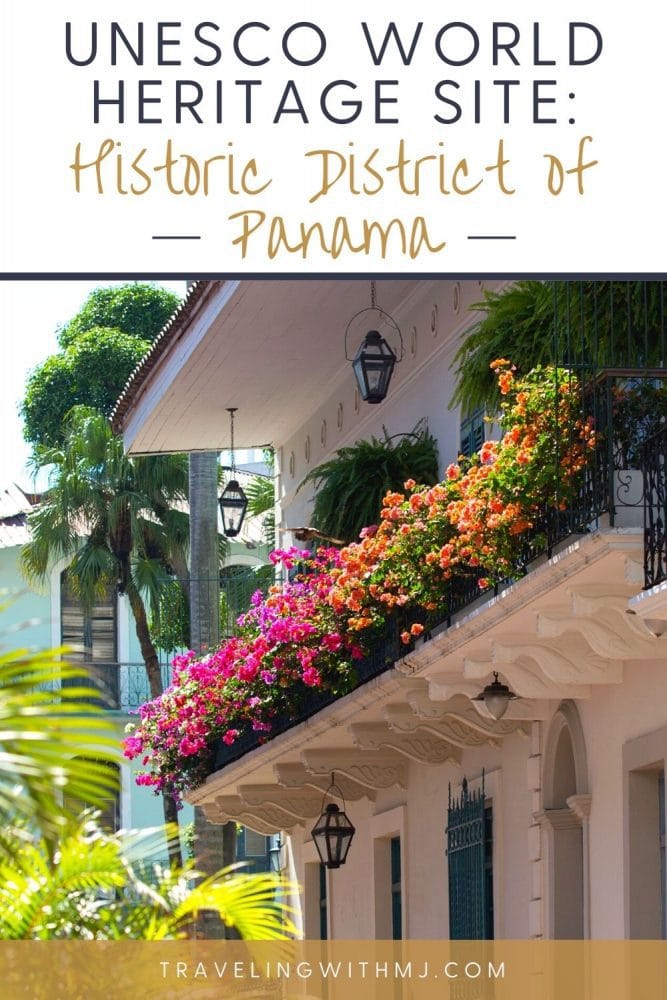Pristine waters, abundant wildlife, and sublime coastline. The beauty of Panama is matchless. Here you can experience a Pacific sunrise and an Atlantic sunset from the same spot. And while Panama City might be renowned globally for its star attraction, the canal, there is far more to see, do, and experience.

Panama City has two sides – the modern, with its skyscraper banks and casinos, and the old town. The old town is referred to as the Historic District of Panama and is a UNESCO World Heritage site. It’s become one of the hippest neighborhoods in the city, also called Casco Viejo (Spanish for the old quarter), and feels like a lifetime away from the skyscraper banks and casinos.
The historic district spans only four avenues and is a UNESCO Site, officially titled Archaeological Site of Panama Viejo and Historic District of Panama. UNESCO World Heritage Sites have legal protection from the United Nations Educational, Scientific, and Cultural Organization. They undergo practical conservation, preserving them from threats or damage from animal or human trespassing, administrative negligence, and uncontrolled access.
A few years back, a visit to the old quarter would have been a risky venture. Gangs ruled the area and kept tourists away. That narrative has changed, and the gentrification of the barrio is fully underway. The regal colonial mansions with their fragile pastel facades are some of Panama’s classiest addresses.
The compact neighborhood now has a thriving gastronomic scene and impressive art galleries. Wander the cobblestone pathways that lead to magnificent churches, Spanish architecture, and the Metropolitan Cathedral.
Enjoy Geisha coffee (grown in the highland areas of Panama, it’s one of the most expensive coffees in the world), enjoy cups of ceviche at the Mercado de Mariscos, or buy an authentic Panama hat. This is Panama.
History of the Historic District of Panama
Founded in 1519, Panama City is the oldest European settlement on the Pacific coast of the Americas. The city was hit many hard times – slave rebellion, fire, and an earthquake, before being destroyed in a pirate attack in the 17th century. The original site was laid out in a slightly irregular, somewhat rudimentary grid of colonial planning.
Panamá Viejo was set up in 1519 by Pedrarías Dávila, aka Pedro Arias de Ávila. The conquistador led Spain’s first major invasion of the New World. Pedrarías Dávila was Panama’s administrator from its inception to 1526 before moving on to Nicaragua. The well-connected Dávila came from a prominent Spanish family, and his grandfather was King Enrique IV adviser.
Dávila had fought in Granada and North Africa, and as a promotion for his gallantry, he succeeded Christopher Columbus as the Indies’ second governor. He was a cruel and hard man with a lust for blood and gold, and in the New World, he quickly launched his ransacking of the Inca Empire.
Dávila created such animosity with the locals that they would make his men drink molten gold if they captured them. It is this drive for riches that made Panama an intercontinental hub and the new town profited from the transport of bullion to Europe.
Panama City became the center of the expansion of the Spanish culture in America. Its stately religious and administrative architecture is a testament to its longevity as a European settlement. The Catholic religion took a foothold in the West Indies from here. The old city also has deep roots in piracy and the slave trade. Not all history is pleasant to learn about.
The Origin of Casco Viejo
By 1520, the slave trade boomed as the Spaniards allowed Genoese merchants to administer business and the port. Trouble came calling when Bayano, an African slave, and his Cimarrons started a revolt in 1552. The first of the Bayano Wars, characterized by guerrilla warfare, took place between 1548 and 1558. The second uprising further destabilized Panama from 1579 to 1582, when the colonial governor called a truce with the slaves. The governor Pedro de Ursúa however, captured Bayano and exiled him to Peru, then Spain.

In 1621, the Panamá Viejo earthquake extensively damaged the region. The municipal buildings, the prison, barracks, and council buildings collapsed. Some religious buildings, such as the Convento de la Concepción, were considerably damaged but have now been partially restored.
Things came to a head in 1671, when Henry Morgan, a Welsh plantation owner and privateer, raided Panama City routing the Spaniards. They razed the city, creating the ruins that make Panamá Viejo.
Two years after the incident, the Spaniards moved the city a little over three miles away from the Pacific shore’s edge to its present location known as the Casco Viejo or the Old Quarter.
In 1826, Simón Bolívar held the Congreso Anfictiónico, a meeting to unite Mexico, Colombia, and Central America. He did not attend it in person, but the event was critical to the Latin American political landscape. Afterward, the transcontinental railroad came calling, and hundreds of thousands of people crossed over following the California Gold Rush.
The old city has a lot of influence from the melding of culture and values, clearly displayed in its military, residential, and religious buildings. It is also the center of ultra-modern Panama City. The old walled quarter covers nearly 55 acres and still has colonial fortifications, landward ditches, and bastions.
Its public buildings and churches are some of the most important legacies of the city’s 17th to 20th-century era. There is a beautiful blend of Spanish colonial, Antillean, and French styles in the cultural sites that dominate the area.
Historic District of Panama Notable Attractions
The Historic District of Panama has an array of outstanding attractions that are of great value to humanity; it’s no wonder it made it to the UNESCO World Heritage List. Here are some of the sights you can tour in the region:
- The old Franciscan convent took up an entire block of the city and stood next to the city wall. The Charter Hall was the venue for Simón Bolívar’s 1826 Amphictyonic Congress. The Franciscan order left Panama in 1821, and then the government took over the building. The site was later a hospital, then a school. The Salón Bolívar is under the care of the Bolivarian Society of Panama, and has undergone extensive restoration. Above the Salón Bolívar is the Sala de Actas (Records Hall) which holds the records of the 1826 congress.
- The Metropolitan Cathedral was built between 1688 and 1796 and is the city’s main Catholic church. It was restored in 2003, and the architecture is a contrast between its old colonial core and modernity.
- The Palacio de las Garzas was built in 1673. Herons’ Palace was the colonial governor’s home but later became the Presidential Palace.
- The Paseo de Las Bovedas built to protect the city is an esplanade atop the sea wall, perfect for photography and the old city’s views.
- Pass by Plaza Herrera, a large plaza surrounded by beautiful ancient buildings. At the center of the plaza is Tomás Herrera’s statue, a general who fought in the Latin American wars for independence against Spain. In 1840, he led Panama’s first war for independence from Colombia.
- Las Bóvedas promenade is another great place to visit. It forms part of the city’s fortifications against pirate attacks. Its jail cells and chambers were restored and now hold several cafes and posh shops.
- Iglesia de La Merced is a small church built in 1680 and is one of the oldest buildings in the Historic District of Panama. It has tiny chapels and white towers with bells. The time-worn baroque-style facade was moved from the Panamá Viejo
- The Canal Museum has tons of information on making the Panama Canal and covers the canal’s cultural, business, and engineering history.
Other Notable Cultural and Historical Sites in the Area
Visit older ruins, an L shape region covering 71 acres. Inside the archaeological site are ruins of public buildings, convents, churches, and elite private homes. There are old bridges and preserved Cuevan aboriginal occupation of the pre-Columbian era.
And a few more impressive religious buildings: St. Mary’s Cathedral, San Jose church, San Felipe Neri church, San Francisco church.
Don’t forget the National Theater and Casa Gongora.
How to Get to the Historic District of Panama
Uber or taxis offer the easiest mode of transportation to Casco Viejo. Your driver will show you a chart that lists zone prices. Although we have never had a problem with taxi fares, it’s always a good idea to agree on the price before heading off.
Car rentals are not an ideal way to visit Casco Viejo. Parking is difficult to find, and the one-way streets are a pain to negotiate. The rush hour traffic and minimal street signs can be frustrating.
An alternative to the cab is the metro to the old town, then taking a short walk to the district. You can also have a hassle-free trip by booking a tour with a local guide. Or, if you’re up to it, take a self-guided walking tour and enjoy all the highlights independently. That’s what we did, and we were able to navigate easily.

Recommended Reading:
The Path Between the Seas by David McCullough
From the #1 “New York Times” and two-time Pulitzer Prizewinning author of “John Adams” and “Truman” comes the national bestselling epic chronicle of the creation of the Panama Canal.
Learn more here.
Is It Safe?
Casco Viejo has a lively nightlife in its clubs and fancy rooftop bars and is safe during the day. There are lots of locals, tourists, and police officers in the old town.
As in all cities, there are areas you should steer clear of at night. We are always a little more cautious at night, regardless of the city we’re in (and that includes here at home). Check with your concierge, front desk, or tour guide for the most current information.
Other UNESCO Sites in Panama
There are four UNESCO sites in Panama in addition to the Historic District of Panama, covering both natural heritage and cultural sites. These are:
- Fortifications on the Caribbean Side of Panama: Portobelo-San Lorenzo
- Coiba National Park
- Darien National Park
- La Amistad National Park
The Final Word
The Historic District of Panama today is a complex grid of streets and blocks of varying sizes. Structures are a blend of 19th and early 20th-century architecture with a colonial, Caribbean, Gulf Coast, French, and Neo-Renaissance flair. The cultural sites dominate the area, with cafes, restaurants, and shops intermingled.
Put Panama and Latin America on your must-visit list.
Pin to your favorite Pinterest board and starting learning – and planning – a trip to the Historic District of Panama (a UNESCO World Heritage Site).


